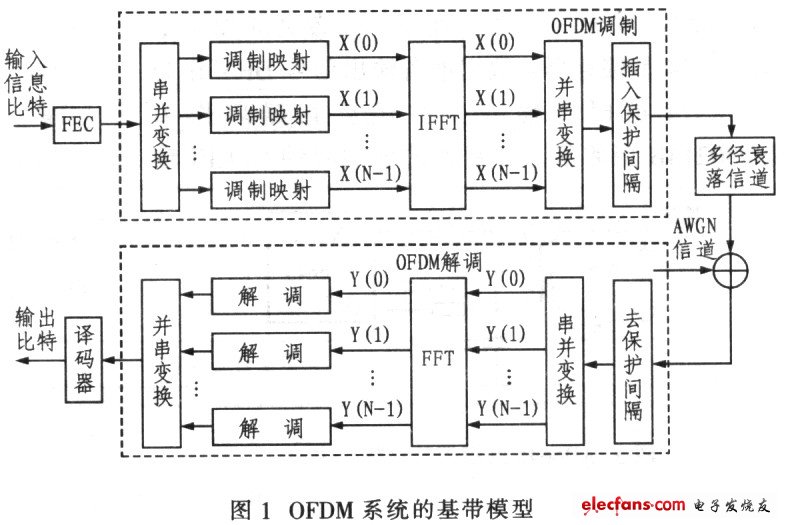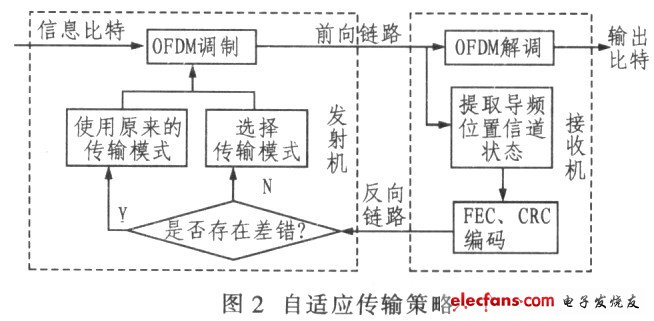l Introduction In recent years, Orthogonal Frequency Division Multiplexing (OFDM) technology has received great attention because of its ability to effectively combat multipath interference (IsI) and increase system capacity. It has been used in digital audio broadcasting (DAB) and digital video broadcasting (DVB). ), Wireless local area network (WLAN) is applied, is a strong competitor of the fourth generation mobile communication system. OFDM is one of the implementations of multi-carrier transmission schemes. In many documents, OFDM is also called discrete multitone (DMT) modulation. It distributes high-speed data streams to multiple sub-carriers through serial-parallel conversion, so that the data symbol duration on each sub-carrier relatively increases, which can effectively increase the system capacity and combat ISI caused by the time dispersion of the wireless channel. The introduction of cyclic prefix (CP) effectively eliminates inter-channel interference (ICI) caused by multipath, thereby maintaining orthogonality between subcarriers. In addition, it can use the fast Fourier transform algorithm to achieve modulation and demodulation, which provides the possibility for its application. 2 Characteristics of OFDM Figure 1 shows the OFDM baseband model. The main advantages of OFDM technology are: it can effectively combat inter-symbol interference caused by multipath propagation, and its implementation complexity is much smaller than that of a single carrier system using an equalizer; on a channel that changes relatively slowly, the OFDM system can be based on each subcarrier The signal-to-noise ratio is optimized to allocate the information bits transmitted on each sub-carrier, thereby greatly increasing the capacity of the system to transmit information: the OFDM system is more resistant to pulse interference than the single-carrier system. Because the demodulation of OFDM signal is integrated in a long symbol period, so that the influence of impulse noise can be dispersed; the spectrum utilization rate is high, the OFDM signal is composed of N signals, and the frequency spectrum of each signal is Sinc Function, and there is a 1/2 overlap with the adjacent signal spectrum, so its spectrum utilization rate: ηOFDM = N / (N + 1) log2M Among them, M is the constellation points. Compared with the MOAM modulation method (ηMQAM = 0.5xlog2M), the spectrum utilization rate is improved by nearly 1 times. Compared with the traditional single carrier transmission system, the main disadvantages of OFDM are: the sensitivity to carrier frequency offset and timing error is higher than that of single carrier system; the signal in OFDM system has a higher peak-to-average power ratio (PAPR) It has high requirements on the linearity of the amplifier; in order to achieve coherent demodulation, channel estimation must be performed. In response to these shortcomings, the three key technologies of OFDM, namely frequency offset estimation, peak-to-average ratio reduction and channel estimation algorithm, have become the current three research hotspots. 3 Application of OFDM in wireless LAN IEEE 802.11a is the standard that OFDM applies to WLAN. IEEE 802.11a works in the 5GHz frequency band. Using OFDM as the physical layer technology, it can provide data rates from 6Mb / s to 54Mb / s. In order to recover the signals on subcarriers in different fading environments, it uses different bitrate coding methods on different subcarriers, mainly including 1/2, 2/3, and 3/4. The 1/2 encoder uses convolutional coding with a constraint length of 7, and the generator polynomial is (133, 171). The other two code rates are obtained by puncturing the 1/2 encoder. Table 1 shows the eight modes supported by IEEE 802.11a for comparison. The table also gives 7 modes supported by HIPERLAN / 2. It can be seen that four kinds of modulation and mapping methods (BPSK, QPSK, 16QAM and 64QAM) are used in IEEE802.11a. Each OFDM symbol has 64 subcarriers, 48 ​​of which transmit data, the guard interval is 800ns, the effective OFDM symbol length is 3.2μs, and the total bandwidth is 20MHz. Its timing synchronization, carrier frequency offset estimation and channel estimation are all completed by 2 pre-training symbols. The training symbol consists of two parts: 10 short training symbols and 2 long training symbols, and the total training time length is 161xs. When selecting short training symbols and long training symbols, the PAPR problem of the system is considered, and the training symbols are selected through reasonable selection. The PAPR can be around 3dB. 4 Adaptive transmission strategy In order to further improve the performance of the system, in response to the characteristics of wireless channels, many literatures have studied adaptive OFDM technology. Including adaptive modulation, coding and interleaving. Through research, it is found that the bit error rate of transmitting OFDM signals on a time-dispersive channel depends on the frequency response of the channel. The error bits are mainly concentrated on the subcarriers with severe fading, and the bit error rate is very low for those subchannels with better channel quality . Therefore, the transmission mode of subcarriers can be dynamically allocated according to the situation of each subchannel. For subchannels with good channel quality, a higher order modulation method and a higher coding rate coding method are used to improve the transmission efficiency of the system; For sub-channels with poor channel quality, low-order modulation and low bit rate coding methods are used. So as to ensure the reliability of system transmission. This is the subcarrier-based adaptive transmission technology SbSA (Subcarrierrier-by-Subcarrier Adapta-TION). Obviously, in order to achieve adaptive transmission, the following three key technologies must be included: the receiver estimates the channel quality based on the pilot signal; the transmitter selects the appropriate transmission method according to the channel conditions; signaling or blind detection technology is used to tell the receiver Transmission parameters. In order for the transmitter to select the correct transmission method, the transmitter must receive the correct channel information. The channel information transmitted on the uplink is erroneous due to the fading or interference of the wireless channel, which will cause the erroneous prediction of the channel by the transmitter. As a result, an inappropriate transmission method is selected, and system performance is degraded. In response to this problem, this paper introduces a more reliable mechanism (see Figure 2), which can still choose a more appropriate transmission method in the case of an error in the reverse link transmission. So as to ensure the performance of the system. This article still assumes that the channel is a slow fading channel, and the channel state information (CSI) of the pilot position received by the receiver is first quantized. Then, the quantized CSI is subjected to cyclic redundancy check coding (CRC) and BPSK modulation. Finally, the CSI information after the CRC is transmitted to the transmitter. If the transmitter detects that the received CSI has no errors. The transmission mode is selected from the alternative modes according to the current channel state. If there is an error, the modulation and coding method at the previous moment is still used. 5 Conclusion In theory. OFDM and single carrier transmission have the same channel capacity. But when there is severe inter-symbol interference or OFDM transmission is used in multipath channels, better performance can be obtained. Recently, the research field that has been widely concerned at home and abroad is the application of OFDM in the next-generation cellular wireless communication system. The combination of OFDM and multi-antenna technology (MIMO) and space-time coding (STC) technology can greatly improve the performance of cellular communication systems.
Socket With Bluetooth Audio Play is a multi-function power
strip, TOUKOO patent product.
With two Bluetooth speakers, you may play
music from each of your mobile devices.
AUX interface provides an option to connect
your desktop as well, like all other ordinary speakers. SB ports power strip provides convenient charging for mobile devices.
PC/ABS flame retardant, phosphor
bronze+pure copper.
Bluetooth or AUX connection loudspeakers 8Ω impedance.
Socket With Bluetooth Audio Play Socket With Bluetooth Audio Play,Usb Ports Power Strip,Extension Socket With Bluetooth Speakers,Electric Outlet With Bluetooth Speakers ZhongShan JITONGLONG Plastic Hardware Co. Ltd. , https://www.toukoo-electronics.com

